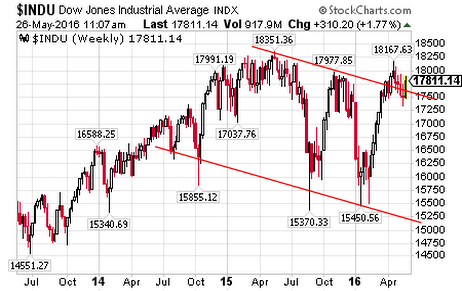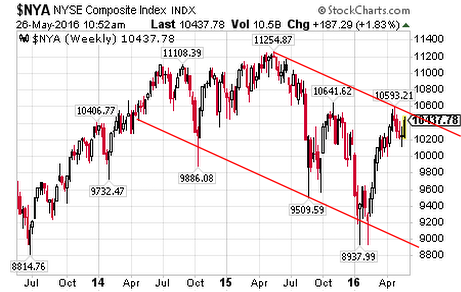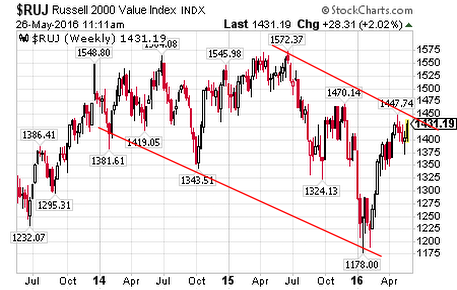4 Simple Charts that Make Me Worry About the Market
Plus, four steps you can take to protect your portfolio.

Whether you have an index fund, an actively managed portfolio or a tactical portfolio, for the past year or so, your portfolio probably has been doing so-so. Not performing poorly, but not doing great either. The portfolios of most investors aren’t crashing; they are sort of running in place.
But we have witnessed huge rallies in recent weeks. And also huge declines. So what’s going on?
To start with, the markets peaked about a year ago. Since then, investors have been on a volatile rollercoaster that has a downward bias.
From just $107.88 $24.99 for Kiplinger Personal Finance
Become a smarter, better informed investor. Subscribe from just $107.88 $24.99, plus get up to 4 Special Issues

Sign up for Kiplinger’s Free Newsletters
Profit and prosper with the best of expert advice on investing, taxes, retirement, personal finance and more - straight to your e-mail.
Profit and prosper with the best of expert advice - straight to your e-mail.
The Dow Jones industrial average peaked at 18,351 a year ago and has had two major declines since then. Each recovery rally has not been able to surpass the peak.

In technical terms, this is the resistance level through which the market needs to advance, or it will likely drop to a lower low than the January low.
But the Dow doesn’t really tell the whole story. Broader markets tell what is really going on.
The New York Stock Exchange also peaked about a year ago, and today it is about 7% off its high. Even after the rally from the January low, the NYSE is at about the same price that it was back in December 2013, almost two and a half years ago. So for two and a half years, the NYSE has basically gone nowhere.

It doesn’t stop there. The Russell 2000 Value index is down almost 9% from its high. Its recovery from the January low only puts it at the same level as October 2013. Again, another broad index that is showing lots of volatility has slowly declined from its peak a year ago and has given up gains for the past two and a half years.

Even the Russell 2000 Growth index is well off its high. It's down more than 15% from its high a year ago. And it has also given back two and a half years of action.

What we are likely seeing is a major top forming. Many of the broader markets are already in decline. Each chart shows lower lows and most show lower highs. This is indicative of a market in decline.
What could change? The Federal Reserve could always intervene. But this is the running out of gas part. How much can the Fed do with rates already near zero?
Some believe that the Fed could go to negative interest rates. What would this tell investors about the economy and markets? That things are so bad, the Fed had to resort to extreme measures?
Some say the Fed could start quantitative easing again by buying more bonds. They already own several trillion dollars' worth of Treasuries. What are they going to do? Buy them all?
Frankly, I wouldn't put it past them. They could do anything. However, the current group at the Fed and Treasury don’t hold a candle to the people that were in charge in 2008, and they couldn’t stop the market from falling apart.
So what is an investor to do? Here are four steps:
1. Clean Up Your Portfolio
Do what Warren Buffett says, and only own the things you would be happy to hold if they closed the market for five or 10 years.
2. Raise Cash
There will likely be some buys when the bear market finally gets going. There are plenty of good solid companies that pay a 3% to 4% dividend today that I would rather buy tomorrow when they yield 6% to 7%. It's hard to buy if you don't have cash.
3. Understand Your Strategy
If you have a tactical strategy, it is not designed to get you out at the top and in at the bottom. It is not designed to play every short-term drop and rally. It is designed to look for major turning points.
If you have a buy and hold strategy, be prepared to hold onto a lot of securities that are dropping in value—a lot. I do not recommend a buy and hold strategy in this environment. (For another view on buy and hold, see Keep Your Investing Simple.)
4. Get a Professional Review
See if your portfolio matches your risk tolerance, your long-term growth objectives, how balanced it is, if its asset allocation is appropriate for the environment and most of all, if there are any highly overvalued securities in your portfolio. Your favorite stock may be a great company, but if the stock is trading well above its fair value, it could quickly become your least favorite stock.
John Riley, registered Research Analyst and the Chief Investment Strategist at CIS, has been defending his clients from the surprises Wall Street misses since 1999.
Disclosure: Third party posts do not reflect the views of Cantella & Co Inc. or Cornerstone Investment Services, LLC. Any links to third party sites are believed to be reliable but have not been independently reviewed by Cantella & Co. Inc or Cornerstone Investment Services, LLC. Securities offered through Cantella & Co., Inc., Member FINRA/SIPC. Advisory Services offered through Cornerstone Investment Services, LLC's RIA. Please refer to my website for states in which I am registered.
Profit and prosper with the best of Kiplinger's advice on investing, taxes, retirement, personal finance and much more. Delivered daily. Enter your email in the box and click Sign Me Up.

In 1999, John Riley established Cornerstone Investment Services to offer investors an alternative to Wall Street. He is unique among financial advisers for having passed the Series 86 and 87 exams to become a registered Research Analyst. Since breaking free of the crowd, John has been able to manage clients' money in a way that prepares them for the trends he sees in the markets and the surprises Wall Street misses.
-
 3 Major Changes to the Charitable Deduction in 2026
3 Major Changes to the Charitable Deduction in 2026Tax Breaks About 144 million Americans may qualify for the 2026 universal charity deduction, while high earners face new IRS limits. Here's what to know.
-
 Where to Stash Cash as Yields Fall, According to Advisers
Where to Stash Cash as Yields Fall, According to AdvisersYour best options depend on how soon you'll need the money and your tolerance for risk.
-
 Control vs Protection Quiz: Which Trust Do You Need?
Control vs Protection Quiz: Which Trust Do You Need?Quiz Take this simple quiz to discover whether a revocable or irrevocable trust should be the cornerstone of your estate plan.
-
 I'm a Financial Pro: You Really Can Make New Year's Money Resolutions That Stick (and Just Smile as Quitter's Day Goes By)
I'm a Financial Pro: You Really Can Make New Year's Money Resolutions That Stick (and Just Smile as Quitter's Day Goes By)The secret to keeping your New Year's financial resolutions? Just make your savings and retirement contributions 100% automatic.
-
 As We Age, Embracing Our Own Self-Doubt Can Be a Gift: A Cautionary Tale About Elder Financial Abuse
As We Age, Embracing Our Own Self-Doubt Can Be a Gift: A Cautionary Tale About Elder Financial AbuseAn aging couple hired a company that illegally required large deposits, and then they decided to stick with the company even after an employee stole from them.
-
 Domestic vs Offshore Asset Protection Trusts: A Basic Guide From an Attorney
Domestic vs Offshore Asset Protection Trusts: A Basic Guide From an AttorneyLearn the difference between domestic asset protection trusts and foreign or offshore asset protection trusts to help you decide what might work best for you.
-
 Now That You've Built Your Estate Planning Playbook, It's Time to Put It to Work
Now That You've Built Your Estate Planning Playbook, It's Time to Put It to WorkYou need to share details with your family (including passwords and document locations) and stay focused on keeping your plan up to date.
-
 I'm a Wealth Adviser: These 10 Strategies Can Help Women Prepare for Their Impending Financial Power
I'm a Wealth Adviser: These 10 Strategies Can Help Women Prepare for Their Impending Financial PowerAs women gain wealth and influence, being proactive about financial planning is essential to address longevity and close gaps in confidence and caregiving.
-
 I'm a Financial Planning Pro: This Is How You Can Stop These 5 Risks From Wrecking Your Retirement
I'm a Financial Planning Pro: This Is How You Can Stop These 5 Risks From Wrecking Your RetirementYour retirement could be jeopardized if you ignore the risks you'll face later in life. From inflation to market volatility, here's what to prepare for.
-
 Are You Hesitating to Spend Money You've Spent Years Saving? Here's How to Get Over It, From a Financial Adviser
Are You Hesitating to Spend Money You've Spent Years Saving? Here's How to Get Over It, From a Financial AdviserEven when your financial plan says you're ready for a big move, it's normal to hesitate — but haven't you earned the right to trust your plan (and yourself)?
-
 Time to Close the Books on 2025: Don't Start the New Year Without First Making These Money Moves
Time to Close the Books on 2025: Don't Start the New Year Without First Making These Money MovesAs 2025 draws to a close, take time to review your finances, maximize tax efficiency and align your goals for 2026 with the changing financial landscape.